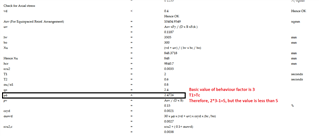RCDC does an excellent job performing seismic ductile wall design according to Eurocode, yet the following areas needs improvement or clarification:
1. According to EN 1998:2004 section 5.4.2.4(4 and 5), seismic walls shall be designed for moment envelope which is shown in figure 5.3. the moment at the base of the structure( Ground floor for building with basements) shall be shifted by a1( tension shift, please refer a book called "Seismic Design of Buildings to Eurocode 8" by Ahmed Y. Elghazouli for the details of a1 calculation). the outcome of this shift is that the wall section would be designed for the maximum base moment for story heights up to the value of a1.
2. According to EN 1998:2004 section 5.4.2.4(6 and 7) ductile seismic walls shall be designed for shear force which is some multiple of the shear obtained from analysis. for DCM the shear force obtained from analysis shall be multiplied by 1.5 and for DCH there is an equation to be solved. for dual systems shear envelope shall be constructed according to figure 5.4 of the code. Is there any code check for this clause in RCDC.
3. According to EN 1998:2004 Section 5.4.3.4.2(6) confined boundary region shall only extend up to the critical height of the building. i.e, after the critical height, which is calculated as per EN 1998:2004 section 5.4.3.4.2(1) , the rules of Eurocode 2( EN 1992:2004) govern. therefore, the confined boundary region confinement detail shall only extend up to the critical height and then it should be replaced by wall detailing according to EN 1992:2004( see EN 1998:2004 section 5.4.3.4.2(11)) RCDC now provides confined boundary element detail for the entire building height, which is incompliant to EN 1998:2015.
4. According to EN 1998:2004 section 5.4.3.4.2(6) the minimum confined boundary region shall be 0.15lw or 1.5bw. RCDC uses other formula to evaluate the minimum confined boundary region length.
5. According to EN 1998:2004 section 5.4.3.4.2(12) if the normalized axial load is less than 0.15 or the normalized axial load is less than 0.2 and behavior factor used in the analysis is reduced by 15%, then the rules of EN 1992:2004 apply to the transverse reinforcement of boundary regions. RCDC doesn't perform code check for this clause.
6. According to EN 1998:2004 section 5.4.3.4.2(8) the longitudinal reinforcement in the confined boundary region shall not be less than 0.005. is there code check for this clause in RCDC.
7. According to EN 1998:2004 section 5.4.3.4.1(4) for composite walls[L,T,U...] the effective flange width on each side of a web should be taken to extend from the face of the web for flexural resistance. please check the code section for the minimum specification. RCDC does the calculation of flexural resistance by calculating the flexural demand from each leg of the composite wall and taking the maximum from each leg at the location where the two legs meet. this should be superseded by the above clause.
8. curvature ductility factor µØ shall be calculated according to EN 1998:2004 equation 5.4or 5.5. according to EN 1998:2004 section 5.2.3.4 for class B reinforcement bar the value of curvature ductility obtained from equation 5.4 or 5.5 shall be multiplied by 1.5. therefore, RCDC shall improve these calculation since it reports wrong values as shown in the picture below. My best guess is this value is the reason why RCDC reports ridiculously high amount of ductile end links. please look into it.

I hope we will see these improvements in the future version. I am open to discussion if needed.